Section 1: Agency overview and resources
1.1 Strategic direction
The mission of the Department of the Treasury (the Treasury) is to improve the wellbeing of the Australian people by providing sound and timely advice to the Government, based on objective and thorough analysis of options, and by assisting Treasury ministers in the administration of their responsibilities and the implementation of government decisions.
Recent natural disasters have come at significant human cost and caused considerable destruction of assets and livelihoods. The economic effects of the recent floods and Cyclone Yasi, and the disastrous events in Japan and New Zealand are, however, temporary, and the outlook is for strong growth, low unemployment and moderate inflation. The positive outlook is underpinned by expected continued strong demand for commodity exports from the Asian region, high terms of trade, and a surge in mining-related business investment. With the economy in good shape, the policy priority is to harness the opportunities created by the mining boom, including through investment in infrastructure and skills development, coupled with further microeconomic reform. With the economy already close to capacity, this requires the movement of resources to the most productive parts of the economy.
The Treasury will focus on providing advice on key risks facing the global economy, including sovereign debt concerns in major advanced economies, high oil prices, inflationary pressures in emerging markets and the economic implications of events in Japan. Particular focus will also be placed on assessing the implications for Australia of economic developments in China and other emerging economies.
The Treasury will continue to support the Government to implement its fiscal strategy. This will involve advice on effective government spending and effective taxation and retirement income arrangements, as well as debt management policy. Underpinning the provision of policy advice on fiscal policy are timely and high quality assessments of domestic and international economic conditions.
The 2010 Intergenerational Report identified a number of long-term challenges for the Australian economy, including an ageing and growing population, climate change, escalating pressures in the health system and the need to support sectoral and regional structural adjustment in the face of a continued commodities boom.
The Treasury will continue to provide advice to the Government on responding to each of these challenges. In particular, over the next year, the Treasury will continue to provide policy advice to the Government on climate change, regional policy, water reform (including in the Murray-Darling Basin), problem gambling, disability services, aged care, Indigenous policy, and skills and education.
The Treasury will also continue to provide policy advice on federal financial relations arrangements, including working with the state and territory governments to deliver national health reform to provide a secure funding partnership for hospitals into the future. The Treasury will also support the review of the distribution of revenue from the Goods and Services Tax (GST) to deliver a simpler, fairer, more predictable and more efficient distribution of the GST to the states and territories.
In 2011-12, the Treasury will have the primary role in assisting the Government to implement its tax reform agenda including improved resource tax arrangements, a cut to the company tax rate, more generous depreciation arrangements for small business and an increase to the Superannuation Guarantee. The Treasury will also organise the tax forum to enable further discussion of the Australia's Future Tax System report and to build on the Government's tax reform agenda.
As its top international engagement priority, the Treasury will continue its deep engagement in the G-20 agenda. In its role as Chair for 2011, France's ambitious agenda necessitates sustained Treasury engagement on the Framework for Strong, Sustainable and Balanced Growth, commodity price issues, reform of the international monetary system and the financial reform agenda. The Treasury will also continue to participate in the OECD and the Global Forum to enhance the effectiveness of implementing international standards of tax information and transparency, as well as maintaining close engagement with the International Monetary Fund and the multilateral development banks. The Treasury will continue its efforts to entrench an East Asia Summit Finance Ministers' Meeting and will remain engaged in the APEC Finance Ministers' Process.
The Treasury will continue to pursue sound regulatory and competition reforms aimed at improving Australia's productivity and international competitiveness. This includes the implementation of a single national consumer policy framework through the Australian Consumer Law, maintaining the effectiveness of Australia's competition law framework, promotion of efficient use of national infrastructure, including in transport, communication and energy markets, and implementation of the National Broadband Network. This work also includes providing advice on the reform of regulatory frameworks for securities markets, financial advice, corporate governance and consumer credit.
In addition, the Treasury will provide advice with the aim of ensuring that the financial system remains robust, competitive and dynamic in order to promote macroeconomic stability and market confidence. The Treasury will continue to monitor prudential frameworks applying to the banking sector, insurers and superannuation funds.
It will also support the independent National Disasters Insurance Review, which is scheduled to report to the Government by 30 September 2011, and will continue to implement the Government's Stronger Super reforms and the Competitive and Sustainable Banking package.
The Treasury will continue to work with the Foreign Investment Review Board to ensure that the foreign investment screening framework maintains the right balance between protecting Australia's national interest and ensuring that Australia remains an attractive destination for foreign capital.
The government infrastructure of Standard Business Reporting (SBR), a multi agency initiative led by the Treasury, was delivered in July 2010. SBR aims to reduce the compliance reporting burden experienced by business in reporting to government. The Treasury will continue to lead the ongoing design and extension of the SBR capabilities, and administrative arrangements involving reporting to government.
The Treasury's policy advice is underpinned by its ability to analyse and anticipate economic issues. Over the period ahead, the Treasury will draw on the depth of expertise across all areas of the organisation to meet the long-term policy challenges facing Australia.
1.2 Agency resource statement
Table 1.1 shows the total resources from all sources. The table summarises how resources will be applied by outcome and by administered and departmental classification.
Table 1.1: Department of the Treasury resource statement — Budget estimates
for 2011-12 as at Budget May 2011
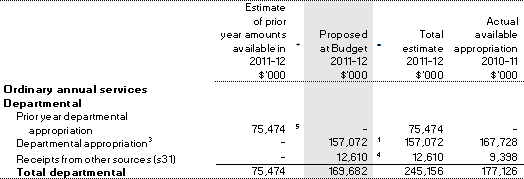
Table 1.1: Department of the Treasury resource statement — Budget estimates
for 2011-12 as at Budget May 2011 (continued)
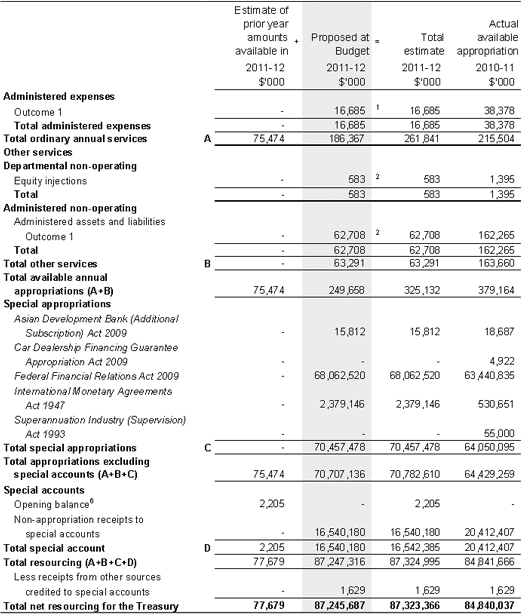
1. Appropriation Bill (No. 1) 2011-12.
2. Appropriation Bill (No. 2) 2011-12.
3. Includes $6.5 million in 2011-12 for the Departmental Ca
pital Budget (also refer to Table 3.2.5).
4. Receipts received under section 31 of the Financial Management and Accountability Act 1997.
5. Estimated adjusted balance carried forward from previous year.
6. Estimated opening balance for special accounts. For further detail on special accounts see Table 3.1.2.
1.3 Budget measures
Budget measures relating to the Treasury are detailed in Budget Paper No. 2, Budget Measures 2011-12 and are summarised below.
Table 1.2: Department of the Treasury 2011-12 Budget measures
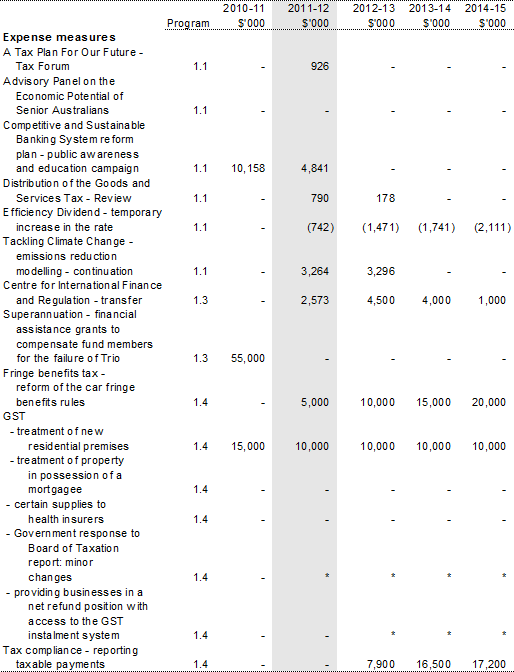
Table 1.2: Department of the Treasury 2011-12 Budget measures (continued)
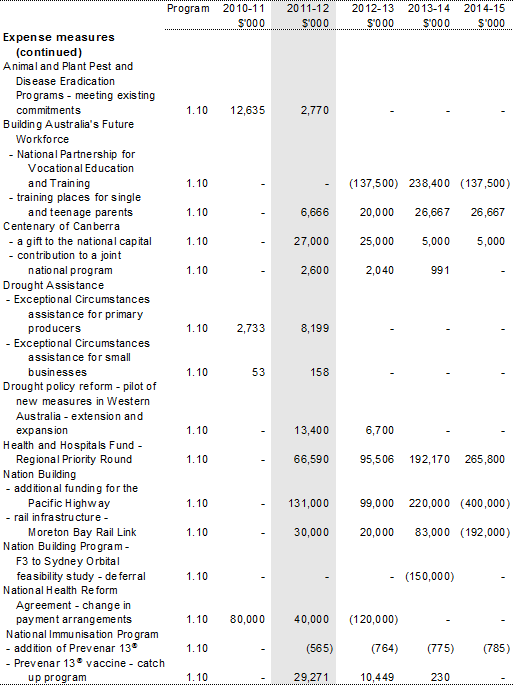
Table 1.2: Department of the Treasury 2011-12 Budget measures (continued)
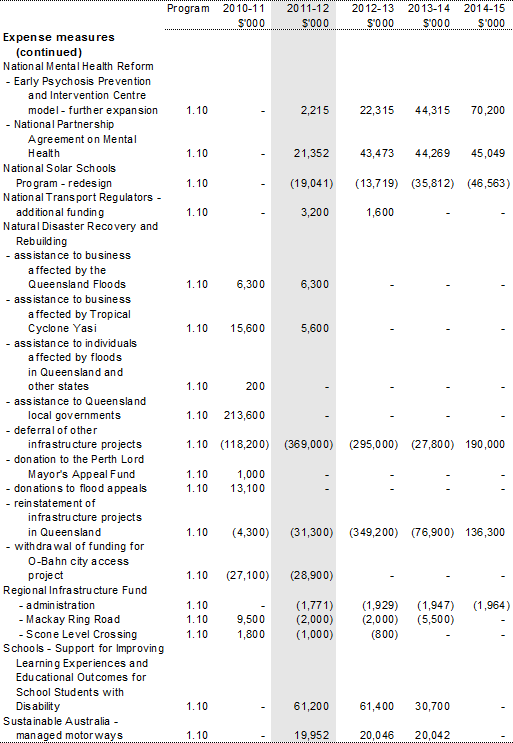
Table 1.2: Department of the Treasury 2011-12 Budget measures (continued)

Prepared on a government finance statistics (fiscal) basis.
Section 2: Outcomes and planned performance
2.1 Outcomes and performance information
Government outcomes are the intended results, impacts or consequences of actions by the Government on the Australian community. Commonwealth programs are the primary vehicle by which government agencies achieve the intended results of their outcome statements. Agencies are required to identify the programs which contribute to Government outcomes over the budget and forward years.
The Treasury's outcome is described below, specifying the strategy, program, objective, deliverables and key performance indicators used to assess and monitor the performance of the Treasury.
Outcome 1: Informed decisions on the development and implementation of policies to improve the wellbeing of the Australian people, including by achieving strong, sustainable economic growth, through the provision of advice to government and the efficient administration of federal financial relations
Outcome 1 strategy
The Treasury contributes to this outcome by providing a range of policy advice to Treasury ministers and government. More specifically the Treasury will provide advice on:
- macroeconomic policy, based on careful monitoring and analysis of economic conditions in Australia and overseas;
- fiscal strategy, budget priorities and measures, and debt and balance sheet management, as well as a budget coordination role;
- Commonwealth-State financial policy, industry, environment and defence policy and housing, social and income support policy;
- taxation and retirement income arrangements consistent with the Government's reform priorities;
- policies that promote competitive, efficient markets and that work to enhance consumer wellbeing, a secure financial system and sound corporate practices, and foreign investment consistent with Australia's national interest;
- policies that promote well regulated, competitive and efficient infrastructure and address supply constraints in the housing market that impact on housing affordability;
- a range of international economic policy issues, including strengthening multilateral regimes underpinning open trade and capital flows, supporting developing countries' development aspirations, and shaping the evolution of regional economic architecture; and
- the administration of a range of payments which are reported in Programs 1.2 to 1.10.
Outcome expense statement
Table 2.1 provides an overview of the total expenses for Outcome 1 by program.
Table 2.1: Budgeted expenses for Outcome 1
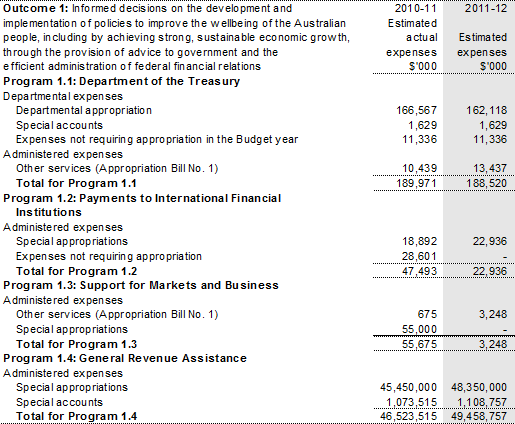
Table 2.1: Budgeted Expenses for Outcome 1 (continued)
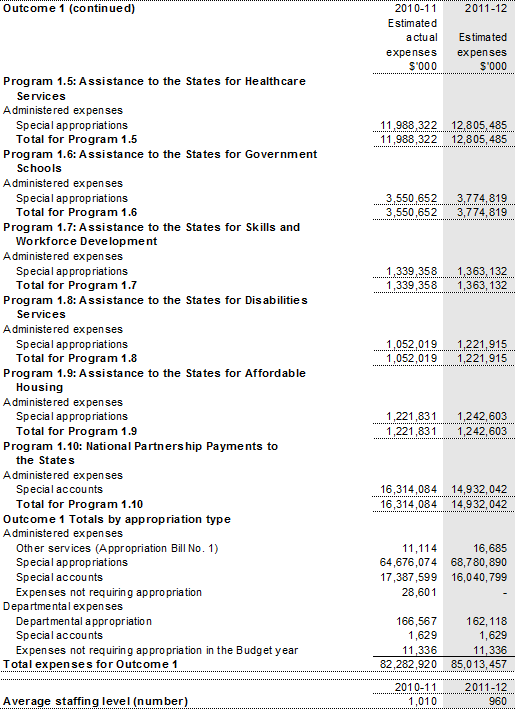
Contributions to Outcome 1
Program 1.1: Department of the Treasury
Program objective
The objectives of the Treasury are:
- promoting a sound macroeconomic environment by monitoring and assessing economic conditions and prospects both in Australia and overseas, and providing advice on macroeconomic policy including fiscal and monetary policy;
- promoting effective government spending arrangements that contribute to the overall fiscal outcomes, influence strong sustainable economic growth and improve the wellbeing of Australians;
- developing effective taxation and retirement income arrangements consistent with the Government's reform priorities; and
- ensuring well functioning markets by providing advice on policies that promote competitive, efficient markets and that work to enhance consumer and investor wellbeing, a secure financial system and sound corporate practices, and foreign investment consistent with Australia's national interest.
Program expenses
Changes in estimates for the forward years predominantly reflect the impact of budget measures.
Table 2.2: Program 1.1 expenses

Program deliverables
The Treasury has four groups that contribute to the achievement of its outcome.
Macroeconomic Group
In 2011-12, Macroeconomic Group will provide advice on:
- domestic and international developments affecting the Australian economy and forecasts of the direction of the Australian and international economies; and
- the setting of sound macroeconomic policies and assessments of government policies.
Macroeconomic Group will also enhance its engagement with the G-20 and regional financial forums, and support and reform the international financial institutions, particularly the International Monetary Fund and World Bank, and further enhance its engagement with China, India, Indonesia and the south-west Pacific reflecting their importance for Australia.
Fiscal Group
In 2011-12, Fiscal Group will provide advice on:
- fiscal strategy which aims to ensure fiscal sustainability over the economic cycle;
- effective government spending arrangements which contribute to improving the wellbeing of Australians;
- strategies that address intergenerational challenges, including social, fiscal and environmental sustainability;
- a range of policy issues including climate change, problem gambling, health reform and regional economics; and
- Commonwealth-State financial relations, including a review of the Goods and Services Tax distribution to the States and Territories.
Fiscal Group will also coordinate the preparation of the Commonwealth Budget and other documents required under the Charter of Budget Honesty Act 1998 and support Commonwealth-State relationships through the coordination and delivery of various Commonwealth-State forums.
Revenue Group
In 2011-12, Revenue Group will provide advice on:
- implementation of the Government's taxation and retirement income reform agenda including a standard tax deduction for work related expenses, a tax discount for incom
e interest, the introduction of a Minerals Resource Rent Tax and extension to the Petroleum Resource Rent Tax, a cut in the company tax rate, more generous depreciation arrangements for small business, an increase to the superannuation guarantee rate and other superannuation reforms arising from the Government's Stronger, Fairer, Simpler package and the Superstream and Self Managed Superannuation Fund elements of the Stronger Super package; - implementation of the Government's 2011-12 Budget decisions that relate to taxation and retirement income arrangements;
- implementation of other Government tax initiatives including the trusts review, research and development tax incentives, specific taxation arrangements for the shipping industry, a new tax regime for Managed Investment Trusts, a household assistance package in support of a price on carbon pollution, increased flexibility for first home saver accounts, not-for-profit sector reforms, foreign source income attribution rules, alternative fuels, sovereign investments and the Tax System Advisory Board;
- delivering the tax forum;
- Australia's participation in international forums, including the OECD, G-20 and the Global Forum in relation to international standards of tax information and transparency;
- a modernised tax treaty network and revised international tax rules which enhance Australia's international attractiveness but address risks from harmful tax jurisdictions; and
- the costs and impacts of tax and retirement income proposals, measures and expenditures, including their distributional impact and overall efficiency.
Markets Group
In 2011-12, Markets Group will provide advice on:
- measures to promote competition, macroeconomic stability and market confidence, including advice on prudential frameworks applying to the banking sector, insurers and superannuation funds;
- the Government's Stronger Super reforms and the Competitive and Sustainable Banking package, and support the independent Natural Disaster Insurance Review which is scheduled to report to the Government by 30 September 2011;
- financial services and corporate reform matters which address emerging issues in investor protection and consumer financial protection, corporate governance and financial reporting, and market integrity;
- initiatives arising from the Australian Financial Centre Forum to strengthen Australia as a regional financial services centre;
- measures to promote the efficient use of national infrastructure, including in transport, communication and energy markets, and improve the responsiveness of the supply side of the housing market;
- completing the implementation of the Australian Consumer Law and the National Consumer Credit Law, and continuing to develop the Phase 2 reforms of the National Consumer Credit Law;
- foreign investment proposals to ensure that they are not contrary to Australia's national interest, and representing Australia's interests on investment and financial service issues in negotiating free trade agreements;
- Standard Business Reporting (SBR), and lead the design and ongoing governance of SBR, including strategic directions, stakeholder take-up, international leadership, architectural and technical leadership and support, the future evolution of SBR services to support future policies and administrative arrangements, and support and priority being maintained for SBR within participating agencies; and
- actuarial matters through the Australian Government Actuary which provides actuarial services to the Government, the Treasury and other agencies.
Program key performance indicators
The Treasury has the following key performance indicators:
- Advice meets the Government's needs in administering its responsibilities and making and implementing decisions. Advice is timely, of high quality, and is based on an objective and thorough understanding of issues and a whole-of-government perspective. The degree of client satisfaction with the quality and timeliness of the advice provided is assessed through feedback mechanisms;
- Timely, high-quality, accurate and transparent Budget, Mid-Year Economic and Fiscal Outlook and Final Budget Outcome documents that meet the expectations of the Government, the Parliament and the public. The budget preparation and coordination process is subject to an annual evaluation;
- Published reports and other information stimulate and inform government and public debate through robust analysis, modelling and research. Publications are timely, high quality and widely available to the public;
- Legislation progressed by the Treasury is in accordance with the principles of good law design and is delivered according to government priorities;
- the majority of prospective tax and retirement income legislation is ready to be introduced into Parliament within 12 months, and the majority of retrospective tax and retirement income legislation within six months, of the Government announcing it; and
- at least one tax or retirement income legislative measure is the subject of a post-implementation review annually.
Program 1.2: Payments to International Financial Institutions
Program objective
Payments are made to the International Monetary Fund (IMF), under the International Monetary Agreements Act 1947, to promote international monetary cooperation, exchange stability and orderly exchange arrangements; to foster economic growth and high levels of employment; and to provide temporary financial assistance to countries to help ease balance of payments adjustments.
Payments are made to other international financial institutions, as required, to facilitate the achievement of government objectives in international forums, including strengthening the international financial system, support for development objectives through the multilateral development banks, and multilateral debt relief.
Program expenses
There are no significant variations to expenses over the forward years. Only expense items are recorded in Table 2.3. Substantial payments are also made to the international financial institutions as administered capital. These payments are shown in Tables 1.1 and 3.2.10.
Table 2.3: Program 1.2 expenses

1. Expenses not requiring appropriation relates to estimated foreign exchange rate movements.
Program deliverables
Payments to international financial institutions, including the IMF, are made with due regard to minimising cost and risk for Australia.
Program key performance indicators
Financial transactions with the international financial institutions, including the IMF, are timely and accurate.
Program 1.3: Support for Markets and Business
Program objective
The Centre for International Finance and Regulation will provide opportunities for research into innovation and development in the global financial sector and best practice financial regulation. Also refer to Budget Paper No. 2, Budget Measures 2011-12.
Payments are made in respect of insurance claims arising from the residual Housing Loans Insurance Company Limited portfolio. The Housing Loans Insurance Company Limited pre-transfer contract portfolio will be managed to ensure all liabilities arising from claims under this portfolio are met and any related debts are recovered.
Payments of assistance are also made to eligible HIH insurance policy holders under the HIH Claims Support Scheme under this program. Payments are not classified as expenses and therefore do not appear in Table 2.4. The HIH Claims Support Scheme is now focused on finalising remaining claims so assistance can be paid, and the claims portfolio wound-up.
Program expenses
The va
riation in estimates across the forward years predominantly relate to the funding profile for the Centre for International Finance and Regulation.
Table 2.4: Program 1.3 expenses
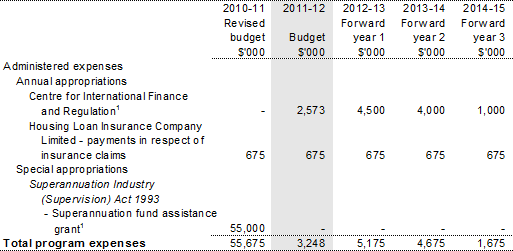
1. This also appears in Table 1.2 Budget Measures.
Program deliverables
The Centre for International Finance and Regulation will be established at a host university or consortium of universities selected through a competitive tender process.
Payments of claims arising from the Housing Loans Insurance Company Limited old book and assistance under the HIH Claims Support Scheme are made according to agreed schedules.
Program key performance indicators
The Centre for International Finance and Regulation will be established during 2011-12. Payments will be accurately determined and made according to the agreed funding schedule.
Payments of claims arising from the Housing Loans Insurance Company Limited old book and assistance under the HIH Claims Support Scheme are accurately determined and are made according to agreed schedules.
Program 1.4: General Revenue Assistance
Program objective
The Government will make general revenue assistance payments to the States and Territories. General revenue assistance payments consist of:
- payments of revenue received from the GST, which in accordance with the Intergovernmental Agreement on Federal Financial Relations, the Commonwealth administers on behalf of the States, which are provided without conditions for each State and Territory to spend according to their own budget priorities;
- payments to the Australian Capital Territory to assist in meeting the additional municipal costs which arise from Canberra's role as the national capital and to compensate for the additional costs resulting from the national capital planning influences on the provision of water and sewerage services;
- payments to Western Australia to compensate for the loss of royalty revenue resulting from the removal in the 2008-09 Budget of the exemption of condensate from crude oil excise;
- payments to Western Australia as a share of royalties collected by the Commonwealth under the Offshore Petroleum (Royalty) Act 2006 in respect of the North West Shelf oil and gas project off the coast of Western Australia;
- payments to the Northern Territory in lieu of royalties on uranium mining in the Ranger Project Area due to the Commonwealth's ownership of uranium in the Northern Territory; and
- payments to New South Wales and Victoria to compensate for Commonwealth taxes paid by Snowy Hydro Ltd in proportion to the States' shareholdings.
Elements of this program are linked to the Resources, Energy and Tourism portfolio. Also refer to Budget Paper No. 3, Australia's Federal Relations 2011-12.
Program expenses
Explanation of changes to program estimates across the forward years can be found in Budget Paper No. 3, Australia's Federal Relations 2011-12.
Table 2.5: Program 1.4 expenses
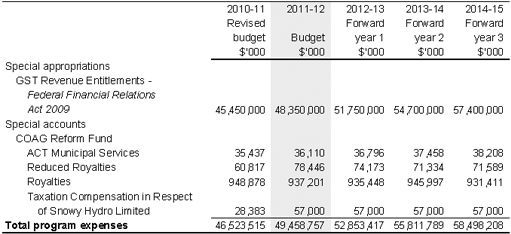
Program deliverables
General revenue assistance payments to the States and Territories are made according to the payment arrangements specified in the Intergovernmental Agreement on Federal Financial Relations.
Program key performance indicators
The Commonwealth Treasury will make general revenue assistance payments to the States and Territories that reflect the requirements, the amounts and timeframes specified in the Intergovernmental Agreement on Federal Financial Relations.
The Commonwealth Treasury will provide GST revenue data on a monthly, quarterly and annual basis, and will maintain a schedule of estimates of annual net GST receipts, in accordance with the requirements of the Intergovernmental Agreement on Federal Financial Relations.
Program 1.5: Assistance to the States for Healthcare Services
Program objective
The Government provides financial support for the States and Territories to be spent in the delivery of healthcare services.
On 13 February 2011, COAG, reached a Heads of Agreement on National Health Reform which will form the basis of negotiations for a new National Health Reform Agreement to be signed by July 2011.
National Health Reform funding will be provided under the National Health Reform arrangements and will commence on 1 July 2012 replacing the National Healthcare Specific Purpose Payment (SPP). National Health Reform funding will have two elements: National Health Reform base funding—to be provided from 1 July 2012 sourced from the existing National Healthcare SPP—and Efficient growth funding—to be provided from 2014-15. National Health Reform funding will be paid into a National Funding Pool to support public hospital services.
Program expenses
Explanation of changes to program estimates across the forward years can be found in Budget Paper No. 3, Australia's Federal Relations 2011-12.
Table 2.6: Program 1.5 expenses
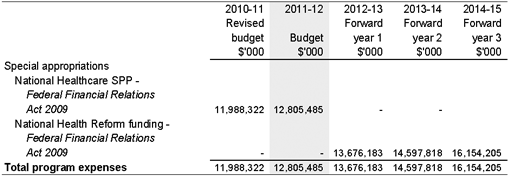
Note: The Federal Financial Relations Act 2009 will be amended to implement the National Health Reform Agreement.
Program deliverables
Payments to the States and Territories are made according to the payment arrangements specified in the Intergovernmental Agreement on Federal Financial Relations.
Program key performance indicators
The Commonwealth Treasury will transfer to each State and Territory the amounts of their monthly and annual entitlements under the National Healthcare SPP and will make the payments on the dates specified in the Intergovernmental Agreement on Federal Financial Relations.
The Commonwealth Treasury will provide advice to the States and Territories on the components of each payment prior to each payment being made.
The States and Territories are required to spend the National Healthcare SPP in the healthcare sector. Each State and Territory Treasurer will provide a report to demonstrate expenditure of the National Healthcare SPP within the healthcare sector in accordance with the Intergovernmental Agreement on Federal Financial Relations. The Commonwealth Treasury will review these reports provided by the States and Territories.
From 1 July 2012, the National Health Reform funding will be paid into a National Funding Pool. The Intergovernmental Agreement on Federal Financial Relations will be amended to reflect the changed payment arrangements for healthcare.
Program 1.6: Assistance to the States for Schools
Program objective
The Government provides financial support for the States and Territories to be spent in the delivery of government and non-government school services.
Although the Treasury makes payments for non-government schools, the funding and expense for the non-government schools component is in the Education, Employment and Workplace Relations portfolio.
Program expenses
Explanation of changes to program estimates across the forward years can be found in Budget Paper No. 3, Australia's Federal Relations 2011-12.
Table 2.7: Program 1.6 expenses

Note: The non-government schools component appears in the Education, Employment and Workplace Relations portfolio and in Budget Paper No.
3, Australia's Federal Relations 2011-12.
Program deliverables
Payments to the States and Territories are made according to the payment arrangements specified in the Intergovernmental Agreement on Federal Financial Relations.
Program key performance indicators
The Commonwealth Treasury will transfer to each State and Territory the amounts of their monthly and annual entitlements under the National Schools SPP (government and non-government schools component) and will make the payments on the dates specified in the Intergovernmental Agreement on Federal Financial Relations.
The Commonwealth Treasury will provide advice to the States and Territories on the components of each payment prior to each payment being made.
The States and Territories are required to spend the National Schools SPP in the schools sector. Each State and Territory Treasurer will provide a report to demonstrate expenditure of the National Schools SPP within the schools sector in accordance with the Intergovernmental Agreement on Federal Financial Relations. The Commonwealth Treasury will review these reports provided by the States and Territories.
Program 1.7: Assistance to the States for Skills and Workforce Development
Program objective
The Government provides financial support for the States and Territories to be spent in the delivery of skills and workforce development services.
Program expenses
Explanation of changes to program estimates across the forward years can be found in Budget Paper No. 3, Australia's Federal Relations 2011-12.
Table 2.8: Program 1.7 expenses

Program deliverables
Payments to the States and Territories are made according to the payment arrangements specified in the Intergovernmental Agreement on Federal Financial Relations.
Program key performance indicators
The Commonwealth Treasury will transfer to each State and Territory the amounts of their monthly and annual entitlements under the National Skills and Workforce Development SPP and will make the payments on the dates specified in the Intergovernmental Agreement on Federal Financial Relations.
The Commonwealth Treasury will provide advice to the States and Territories on the components of each payment prior to each payment being made.
The States and Territories are required to spend the National Skills and Workforce Development SPP in the skills and workforce sector. Each State and Territory Treasurer will provide a report to demonstrate expenditure of the National Skills and Workforce Development SPP within the skills and workforce sector in accordance with the Intergovernmental Agreement on Federal Financial Relations. The Commonwealth Treasury will review these reports provided by the States and Territories.
Program 1.8: Assistance to the States for Disability Services
Program objective
The Government provides financial support for the States and Territories to be spent in the delivery of disability services.
From 1 July 2011, the Commonwealth will make an adjustment to ensure that the changes to Commonwealth and State roles and responsibilities for aged care and disability services, as part of the National Health Reform arrangements, are budget neutral. Subject to further negotiations on elements of the National Health Reform arrangements, it is anticipated that the adjustment to achieve budget neutrality will be made to either the National Healthcare SPP or the National Disability SPP.
Program expenses
Explanation of changes to program estimates across the forward years can be found in Budget Paper No. 3, Australia's Federal Relations 2011-12.
Table 2.9: Program 1.8 expenses
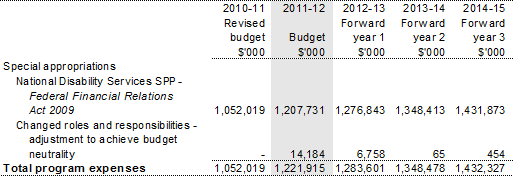
Program deliverables
Payments to the States and Territories are made according to the payment arrangements specified in the Intergovernmental Agreement on Federal Financial Relations.
Program key performance indicators
The Commonwealth Treasury will transfer to each State and Territory the amounts of their monthly and annual entitlements under the National Disability Services SPP and will make the payments on the dates specified in the Intergovernmental Agreement on Federal Financial Relations.
The Commonwealth Treasury will provide advice to the States and Territories on the components of each payment prior to each payment being made.
The States and Territories are required to spend the National Disability Services SPP in the disability services sector. Each State and Territory Treasurer will provide a report to demonstrate expenditure of the National Disability Services SPP within the disability services sector in accordance with the Intergovernmental Agreement on Federal Financial Relations. The Commonwealth Treasury will review these reports provided by the States and Territories.
Program 1.9: Assistance to the States for Affordable Housing
Program objective
The Government provides financial support for the States and Territories to be spent in the delivery of affordable housing services.
Program expenses
Explanation of changes to program estimates across the forward years can be found in Budget Paper No. 3, Australia's Federal Relations 2011-12.
Table 2.10: Program 1.9 expenses

Program deliverables
Payments to the States and Territories are made according to the payment arrangements specified in the Intergovernmental Agreement on Federal Financial Relations.
Program key performance indicators
The Commonwealth Treasury will transfer to each State and Territory the amounts of their monthly and annual entitlements under the National Affordable Housing SPP and will make the payments on the dates specified in the Intergovernmental Agreement on Federal Financial Relations.
The Commonwealth Treasury will provide advice to the States and Territories on the components of each payment prior to each payment being made.
The States and Territories are required to spend the National Affordable Housing SPP in the affordable housing sector. Each State and Territory Treasurer will provide a report to demonstrate expenditure of the National Affordable Housing SPP within the affordable housing sector in accordance with the Intergovernmental Agreement on Federal Financial Relations. The Commonwealth Treasury will review these reports provided by the States and Territories.
Program 1.10: National Partnership Payments to the States
Program objective
The Government provides financial support for the States and Territories to be spent on improving outcomes in the areas specified in each of the National Partnership agreements. These payments support the delivery of specified outputs or projects, facilitate reforms or reward those jurisdictions that deliver on nationally significant reforms.
This program is linked to the Agriculture, Fisheries and Forestry portfolio, Attorney-General's portfolio; Broadband, Communications and the Digital Economy portfolio; Climate Change and Energy Efficiency portfolio; Defence portfolio; Defence portfolio (Department of Veterans' Affairs); Education, Employment and Workplace Relations portfolio; Families, Housing, Community Services and Indigenous Affairs portfolio; Finance and Deregulation portfolio; Health and Ageing portfolio; Infrastructure and Transport portfolio; Prime Minister and Cabinet portfolio; Prime Minister and Cabinet po
rtfolio (Department of Regional Australia, Regional Development and Local Government); Resources, Energy and Tourism portfolio; and Sustainability, Environment, Water, Population and Communities portfolio. Also refer to Budget Paper No. 3, Australia's Federal Relations 2011-12.
Program expenses
Explanation of changes to program estimates across the forward years can be found in Budget Paper No. 3, Australia's Federal Relations 2011-12.
Table 2.11: Program 1.10 expenses
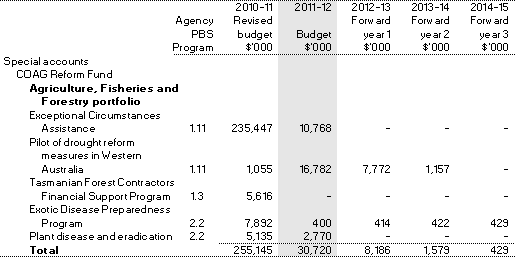
Table 2.11: Program 1.10 expenses (continued)
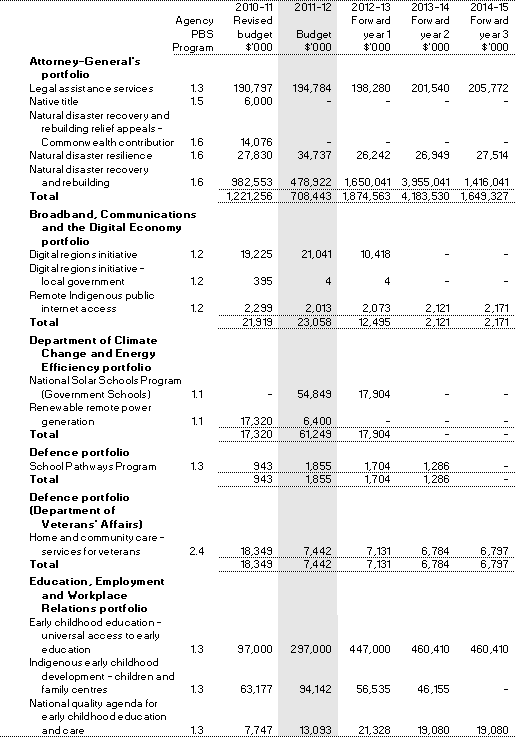
Table 2.11: Program 1.10 expenses (continued)
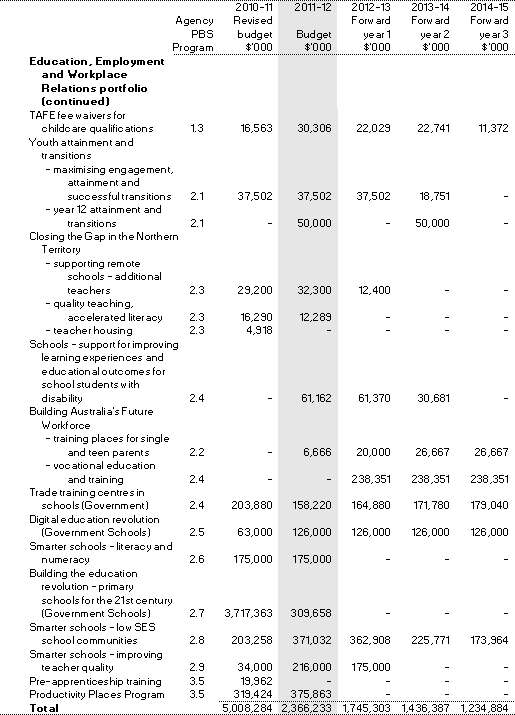
Table 2.11: Program 1.10 expenses (continued)
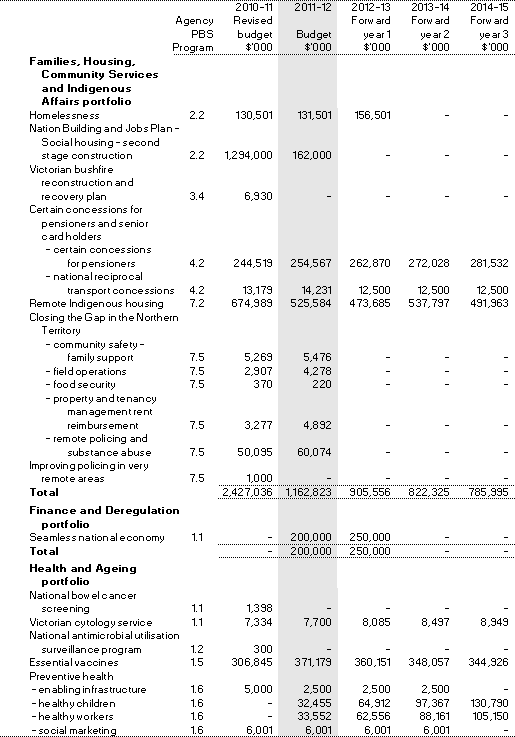
Table 2.11: Program 1.10 expenses (continued)
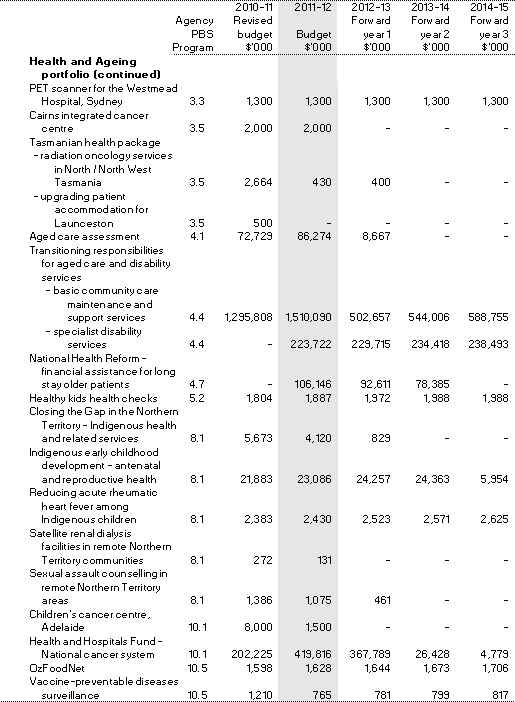
Table 2.11: Program 1.10 expenses (continued)
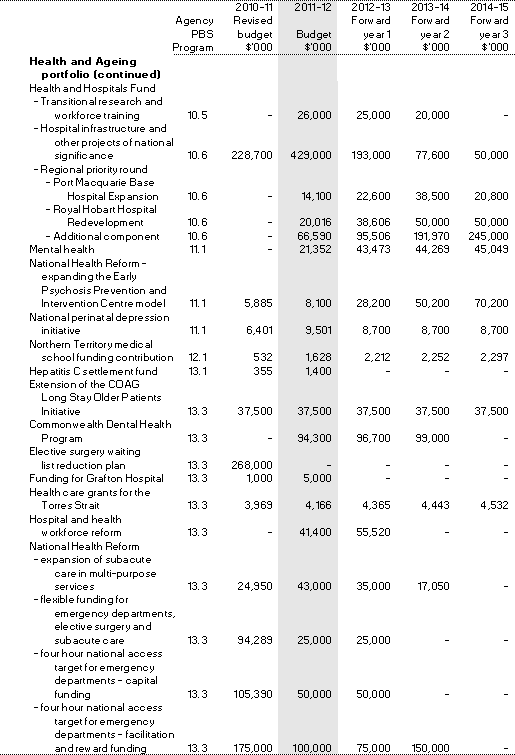
Table 2.11: Program 1.10 expenses (continued)
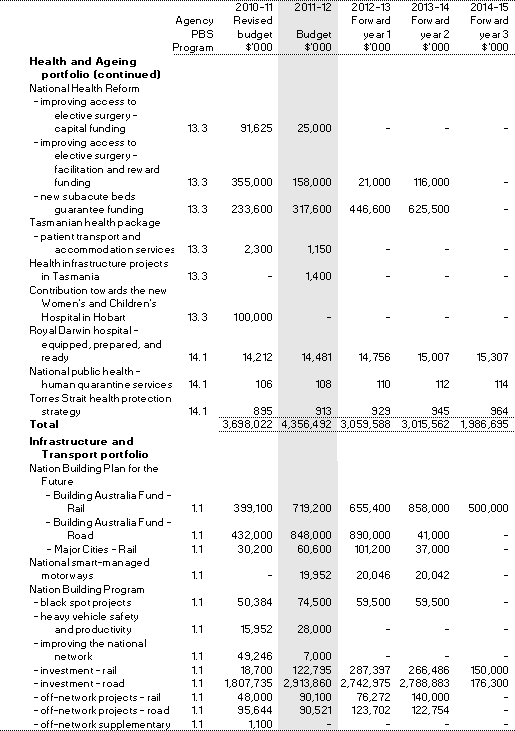
Table 2.11: Program 1.10 expenses (continued)
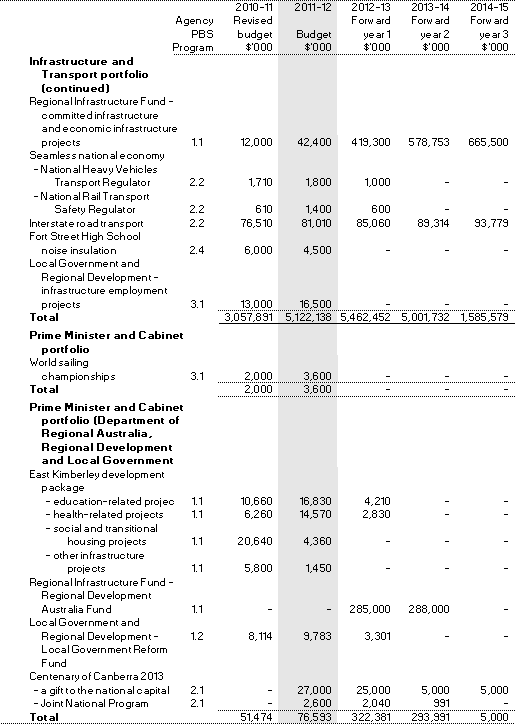
Table 2.11: Program 1.10 expenses (continued)
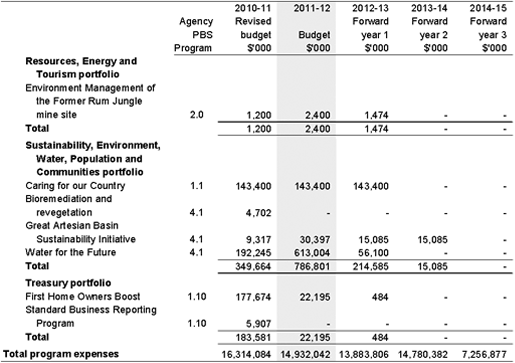
Note: These items can also be found in Budget Paper No. 3, Australia's Federal Relations 2011-12.
Program deliverables
Payments to the States and Territories will be made on the basis set out in each of the National Partnership agreements and any related agreements.
Program key performance indicators
The Commonwealth Treasury will make payments to the States and Territories that reflect the requirements, the amounts and timeframes set out in each of the National Partnership agreements and any related agreements. These payments will only be made upon the Commonwealth Treasury's receipt of authorisations from the relevant agency in respect of performance benchmarks or payment schedules set out in each of the National Partnership agreements.
The Commonwealth Treasury will provide advice to the States and Territories on the components of each payment prior to each payment being made.
Section 3: Explanatory tables and budgeted financial statements
Section 3 presents explanatory tables and budgeted financial statements which provide a comprehensive snapshot of the Treasury's finances for 2011-12. It explains how budget plans are incorporated into the financial statements and provides further details of the reconciliation between appropriations and program expenses, movements in administered funds, special accounts and government Indigenous expenditure.
3.1 Explanatory tables
3.1.1 Movement of administered funds between years
Administered funds can be provided for a specified period, for example under annual Appropriation Acts. Funds not used in the specified period with the agreement of the Finance Minister may be moved to a future year. Table 3.1.1 shows the movement of administered funds approved between years.
Table 3.1.1: Movement of Administered Funds between years

1. The movement of funds relates to the expected delay in the Competitive and Sustainable Banking System reform plan — public awareness and education campaign that is now expected to commence in 2011-12 rather than 2010-11.
3.1.2 Special accounts
Special accounts provide a means to set aside and record amounts used for specified purposes. Special accounts can be created by a Finance Minister's Determination under the Financial Management and Accountability Act 1997 or under separate enabling legislation. Table 3.1.2 shows the expected additions (receipts) and reductions (payments) for each account used by the Treasury.
Table 3.1.2: Estimates of special account cash flows and balances
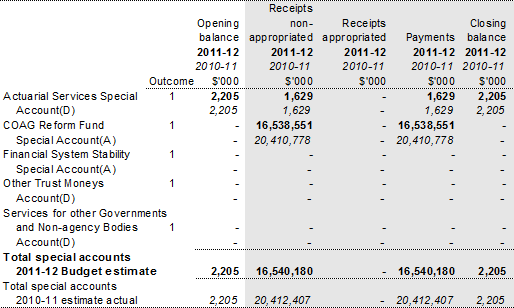
(A) Administered.
(D) Departmental.
3.1.3 Australian Government Indigenous Expenditure
The Treasury does not have any Australian Government Indigenous Expenditure.
3.2 Budgeted financial statements
3.2.1 Differences in agency resourcing and financial statements
There are no material differences between the resource information presented in the Budget Papers and Portfolio Budget Statements as a result of differences between Australian Accounting Standards and Government Finance Statistics.
3.2.2 Analysis of budgeted financial statements
The Treasury is budgeting towards a departmental breakeven operating result for 2011-12 after non appropriated expenses are added back.
The Treasury has a sound financial position and currently has sufficient cash reserves to fund provisions and payables, and asset replacement, as they fall due.
3.2.3 Budgeted financial statements tables
Table 3.2.1: Budgeted departmental comprehensive income statement
(for the period ended 30 June)
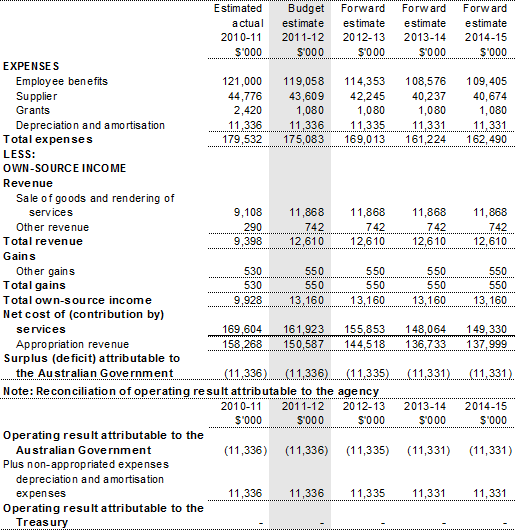
Prepared on Australian Accounting Standards basis.
Table 3.2.2: Budgeted departmental balance sheet
(as at 30 June)
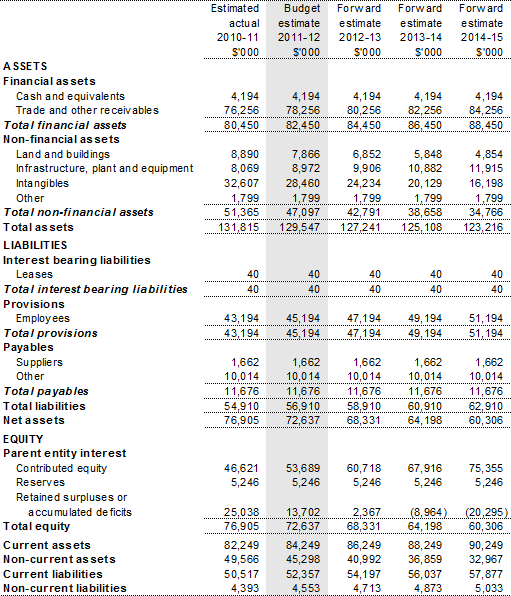
Prepared on Australian Accounting Standards basis.
Table 3.2.3: Budgeted departmental statement of cash flows
(for the period ended 30 June)
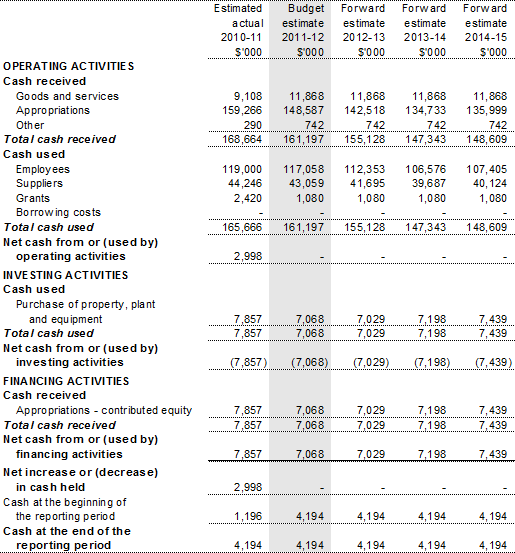
Prepared on Australian Accounting Standards basis.
Table 3.2.4: Departmental statement of changes in equity — summary of movement
(budget year 2011-12)
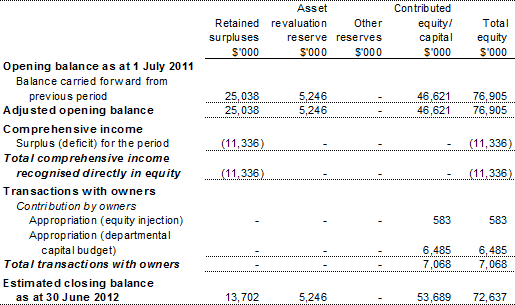
Prepared on Australian Accounting Standards basis.
Table 3.2.5: Departmental capital budget (DCB) statement
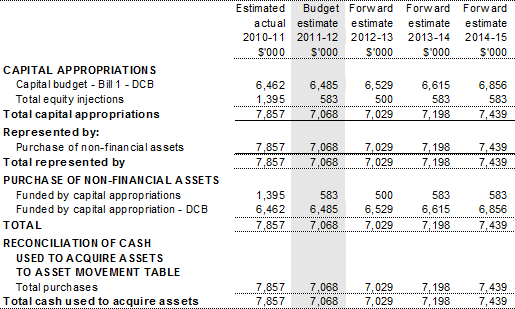
Prepared on Australian Accounting Standards basis.
Table 3.2.6: Statement of asset movements (budget year 20
11-12)
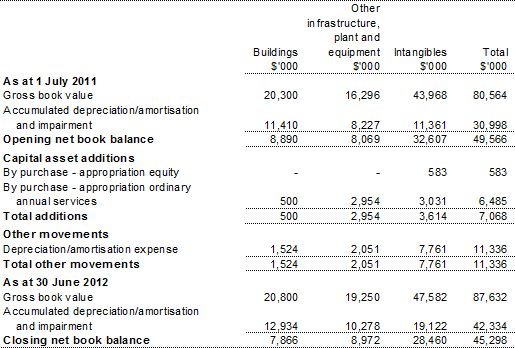
Prepared on Australian Accounting Standards basis.
Table 3.2.7: Schedule of budgeted income and expenses administered on behalf of
government (for the period ended 30 June)
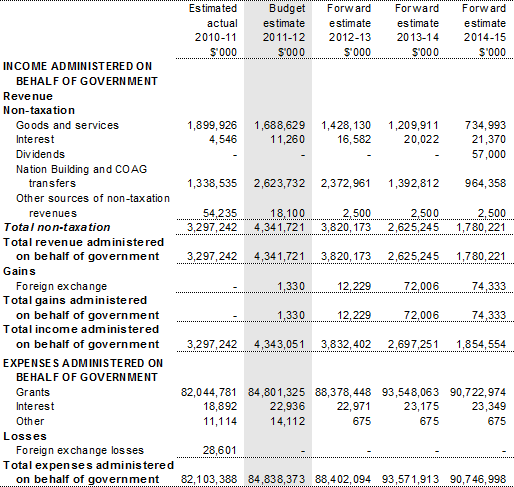
Prepared on Australian Accounting Standards basis.
Table 3.2.8: Schedule of budgeted assets and liabilities administered on behalf of
government (as at 30 June)
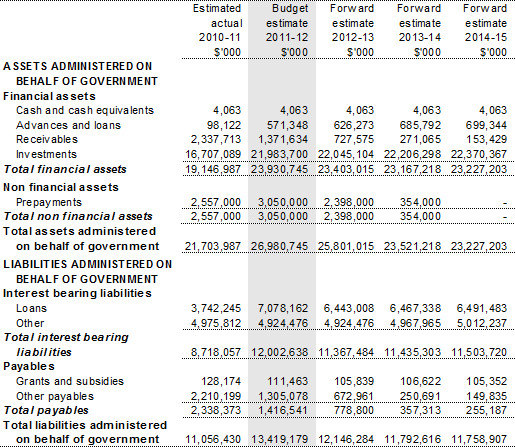
Prepared on Australian Accounting Standards basis.
Table 3.2.9: Schedule of budgeted administered cash flows
(for the period ended 30 June)
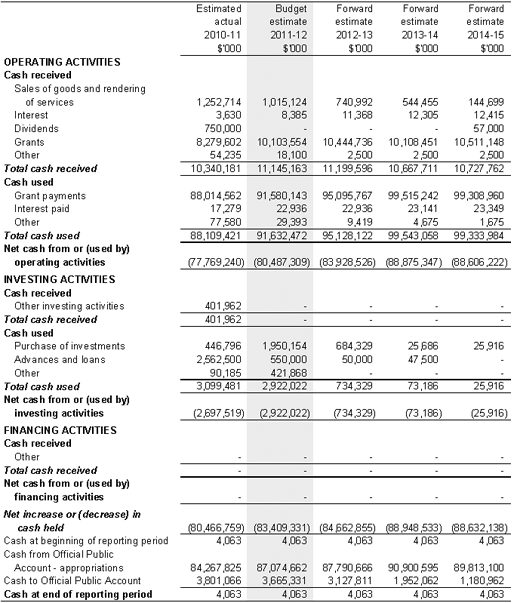
Prepared on Australian Accounting Standards basis.
Table 3.2.10: Schedule of administered capital budget
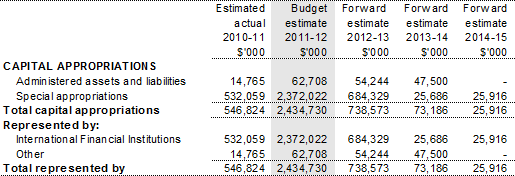
Prepared on Australian Accounting Standards basis.
3.2.4 Notes to the financial statements
The Treasury's budgeted statements are prepared on an accrual basis in accordance with:
- the Government's financial budgeting and reporting framework; and
- Australian Accounting Standards and Interpretations issued by the Australian Accounting Standards Board.
Under the Government's accrual budgeting framework, and consistent with Australian Accounting Standards, transactions that departments control (departmental transactions) are separately budgeted for, and reported on, from transactions departments do not have control over (administered transactions). This ensures that departments are only held accountable for the transactions over which they have control.
Departmental assets, liabilities, revenues and expenses are controlled by the department. Departmental expenses include employee and supplier expenses and other administrative costs, which are incurred by the department in providing goods and services.
Administered items are revenues, expenses, assets or liabilities which are managed by the department on behalf of the Government according to set government directions. Administered expenses include subsidies, grants and personal benefit payments, and administered revenues include taxes, fines and excises.